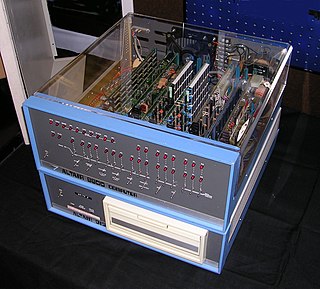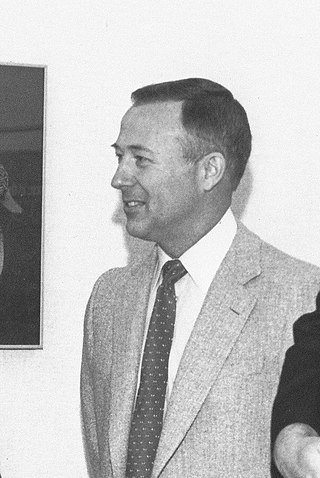
The Apple Computer 1 (Apple-1), later known predominantly as the Apple I, is an 8-bit motherboard-only personal computer designed by Steve Wozniak and released by the Apple Computer Company in 1976. The company was initially formed to sell the Apple I – its first product – and would later become the world's largest technology company. The idea of starting a company and selling the computer came from Wozniak's friend and Apple co-founder Steve Jobs. One of the main innovations of the Apple I was that it included video display terminal circuitry and a keyboard interface on a single board, allowing it to connect to a low-cost composite video monitor instead of an expensive computer terminal, compared to most existing personal computers at the time such as the Altair 8800 and other S-100 bus based machines.

Gary Arlen Kildall was an American computer scientist and microcomputer entrepreneur. During the 1970s, Kildall created the CP/M operating system among other operating systems and programming tools, and subsequently founded Digital Research, Inc. to market and sell his software products. Kildall was among the earliest individuals to recognize microprocessors as fully capable computers, and to organize a company around this concept. Due to his accomplishments during this era, Kildall is considered a pioneer of the personal computer revolution.

The 6800 is an 8-bit microprocessor designed and first manufactured by Motorola in 1974. The MC6800 microprocessor was part of the M6800 Microcomputer System that also included serial and parallel interface ICs, RAM, ROM and other support chips. A significant design feature was that the M6800 family of ICs required only a single five-volt power supply at a time when most other microprocessors required three voltages. The M6800 Microcomputer System was announced in March 1974 and was in full production by the end of that year.

The Homebrew Computer Club was an early computer hobbyist group in Menlo Park, California, which met from March 1975 to December 1986. The club had an influential role in the development of the microcomputer revolution and the rise of that aspect of the Silicon Valley information technology industrial complex.

The Altair 8800 is a microcomputer designed in 1974 by MITS and based on the Intel 8080 CPU. Interest grew quickly after it was featured on the cover of the January 1975 issue of Popular Electronics and was sold by mail order through advertisements there, in Radio-Electronics, and in other hobbyist magazines. According to Harry Garland, the Altair 8800 was the product that catalyzed the microcomputer revolution of the 1970s. It was the first commercially successful personal computer. The computer bus designed for the Altair was to become a de facto standard in the form of the S-100 bus, and the first programming language for the machine was Microsoft's founding product, Altair BASIC.

The S-100 bus or Altair bus, IEEE 696-1983(withdrawn), is an early computer bus designed in 1974 as a part of the Altair 8800. The S-100 bus was the first industry standard expansion bus for the microcomputer industry. S-100 computers, consisting of processor and peripheral cards, were produced by a number of manufacturers. The S-100 bus formed the basis for homebrew computers whose builders implemented drivers for CP/M and MP/M. These S-100 microcomputers ran the gamut from hobbyist toy to small business workstation and were common in early home computers until the advent of the IBM PC.
"An Open Letter to Hobbyists" is a 1976 open letter written by Bill Gates, the co-founder of Microsoft, to early personal computer hobbyists, in which Gates expresses dismay at the rampant software piracy taking place in the hobbyist community, particularly with regard to his company's software.

The IMSAI 8080 is an early microcomputer released in late 1975, based on the Intel 8080 and S-100 bus. It is a clone of its main competitor, the earlier MITS Altair 8800. The IMSAI is largely regarded as the first "clone" microcomputer. The IMSAI machine runs a highly modified version of the CP/M operating system called IMDOS. It was developed, manufactured and sold by IMS Associates, Inc.. In total, between 17,000 and 20,000 units were produced from 1975 to 1978.
Micro Instrumentation and Telemetry Systems (MITS) was an American electronics company founded in Albuquerque, New Mexico that began manufacturing electronic calculators in 1971 and personal computers in 1975.
ComputerLand was a widespread chain of retail computer stores during the early years of the microcomputer revolution, and was one of the outlets chosen to introduce the IBM PC in 1981. The first ComputerLand opened in 1976, and the chain eventually included about 800 stores by 1985. After this time the rapid commoditization of the PC led to the company's downfall, with most of the retail locations closing by 1990. The company officially ended in February 1999.

Henry EdwardRoberts was an American engineer, entrepreneur and medical doctor who invented the first commercially successful personal computer in 1974. He is most often known as "the father of the personal computer." He founded Micro Instrumentation and Telemetry Systems (MITS) in 1970 to sell electronics kits to model rocketry hobbyists, but the first successful product was an electronic calculator kit that was featured on the cover of the November 1971 issue of Popular Electronics. The calculators were very successful and sales topped one million dollars in 1973. A brutal calculator price war left the company deeply in debt by 1974. Roberts then developed the Altair 8800 personal computer that used the new Intel 8080 microprocessor. This was featured on the cover of the January 1975 issue of Popular Electronics, and hobbyists flooded MITS with orders for this $397 computer kit.
Electric Pencil, released in December 1976 by Michael Shrayer, was the first word processor for home computers.

Processor Technology Corporation was a personal computer company founded in April 1975, by Gary Ingram and Bob Marsh in Berkeley, California. Their first product was a 4K byte RAM board that was compatible with the MITS Altair 8800 computer but more reliable than the MITS board. This was followed by a series of memory and I/O boards including a video display module.
IMDOS was a modified version of the CP/M operating system for Intel 8080 processors, used by IMS Associates, Inc. (IMS) for their IMSAI 8080 personal computer. Since MITS would not license their operating system to other manufacturers, IMS approached Gary Kildall and paid a fixed fee of $25,000 for a non-exclusive CP/M license.

William "Bill" Millard is the founder of IMS Associates, makers of the IMSAI series of computers and the electronics retailer ComputerLand. He is credited as the "father" of modern computer retailing. He has also been called one of the world's most elusive tax exiles.
Cromemco was a Mountain View, California microcomputer company known for its high-end Z80-based S-100 bus computers and peripherals in the early days of the personal computer revolution.

RCA is an American multinational trademark brand owned by Talisman Brands, Inc. which is used on products made by that company as well as Sony Music Entertainment, Voxx International and ON Corporation. 'RCA' is an abbreviation for the Radio Corporation of America, founded in 1919. The company became known as the RCA Corporation in 1969. RCA was purchased by General Electric in 1986 and its various divisions and assets were then liquidated.

The Cromemco Dazzler was a graphics card for S-100 bus computers introduced in a Popular Electronics cover story in 1976. It was the first color graphics card available for microcomputers. The Dazzler was the first of a succession of increasingly capable graphics products from Cromemco which, by 1984, were in use at 80% of all television stations in the U.S. for the display of weather, news, and sports graphics.
Parasitic Engineering, Inc., was an American computer company founded by Howard Fullmer and Gene Nardi in 1974. Named as a tongue-in-cheek reference to a comment by MITS co-founder Ed Roberts, Parasitic's first products were hardware upgrade kits to MITS' Altair 8800 microcomputer kit, improving the latter's power supply rating and susceptibility to noise. The company later released their own microcomputer based on the same bus as the Altair, the S-100, but it was less popular than the company's hardware-improvement kits. By 1979, the company had pivoted to providing upgrades to Tandy's TRS-80. Parasitic went defunct in 1983.
Gnat Computers, Inc. was an American computer company based in San Diego, California, founded in 1976. The company was an early developer of microcomputers and one of the first—if not the first—to license the CP/M operating system from Digital Research. They released various computer hardware, including two microcomputer systems, before they were acquired by business partner Data Technology Industries, Inc., in 1983.













